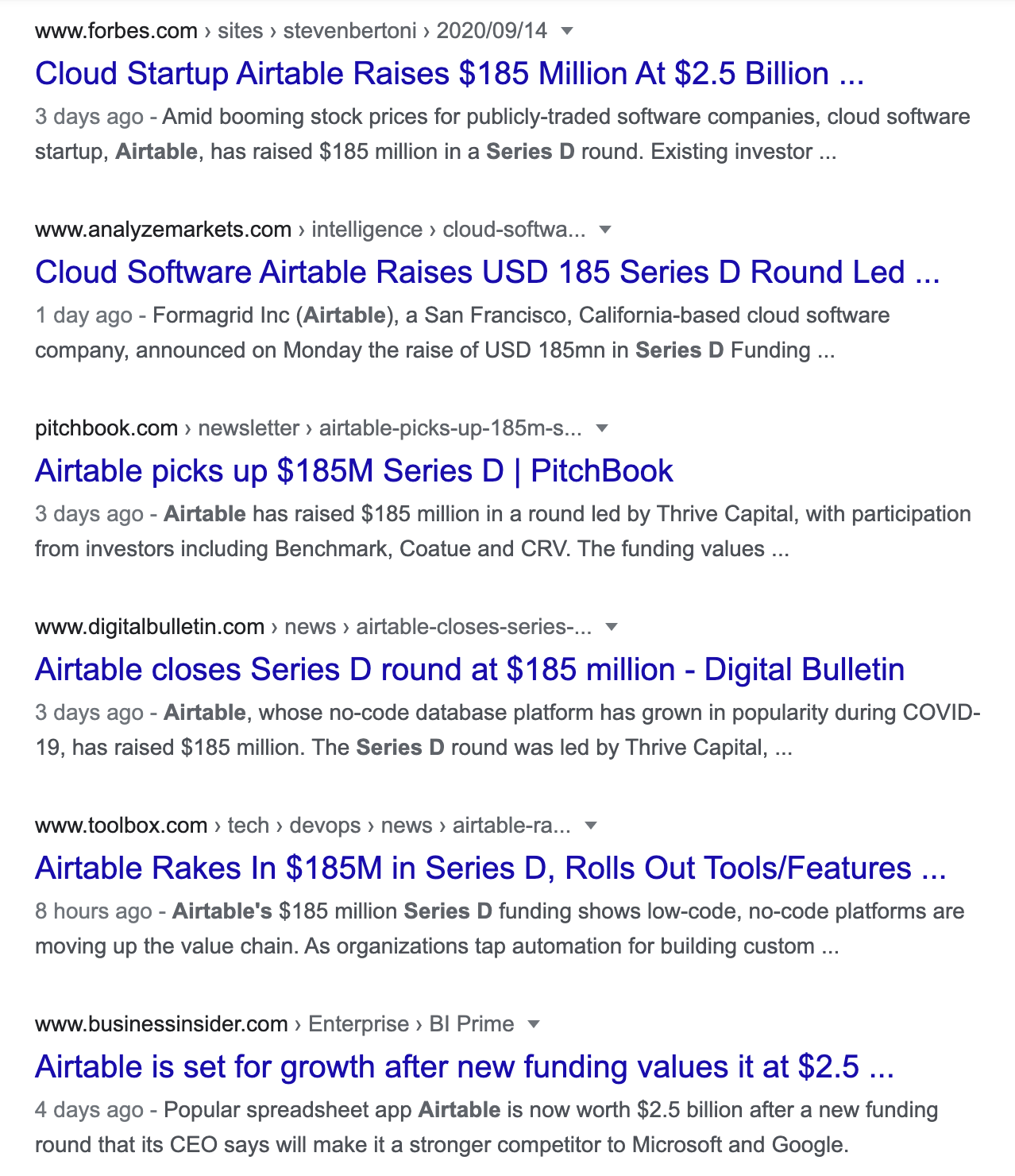Airtable: Timing is Everything
Alfred Lua / Written on 18 September 2020
Earlier this week, Airtable made a huge announcement. The team raised $185 million and launched three major features—Airtable Apps, Airtable Automation, and Airtable Sync.
From TechCrunch:
The spreadsheet-centric database and no-code platform Airtable today announced that it has raised a $185 million Series D funding round, putting the company at a $2.585 billion post-money valuation.
...
In addition, the company is also launching one of its largest feature updates today, which starts to execute on the company’s overall platform vision that goes beyond its current no-code capabilities and brings tools to the service more low-code features, as well new automation (think IFTTT for Airtable) and data management.
This is one of the most coordinated launches I have seen recently. The team announced their new funding round, released a major update to their product, launched a marketplace of apps, got TechCrunch coverage—an interview on TechCrunch Disrupt and an article—and it was CEO Howie Liu's birthday. All on the same day. Talk about timing!
Fundraising and product release
It's often hard to get press coverage for product launches unless there is a great story angle to it. (Or unless you are Facebook, Apple, Twitter, or the likes.) Even though it is one of Airtable's largest updates, if the Airtable team had simply launched those new features, tech publications likely would not have covered it. Improving the product is expected; it's not a piece of news that would attract much traffic and shares.
But fund raising is different. When a startup, especially one like Airtable which is already a unicorn, raises more money, tech publications would rush to write about it. And people would be more interested in reading about it. So it's brilliant that the Airtable team timed a major product launch with their funding round announcement to amplify the reach of their product launch. Furthermore, they put together a great story for the reporters to tell: Airtable raised $185 million to help software users become software builders, and here are the new features to enable that. You can see this in the TechCrunch article:
Just as important as the new funding though, are the various new features the company is launching today.
Airtable having three new features isn't worth reporting about. But Airtable raising $185 million to help people build software themselves is. This story allowed them to get press coverage and promote their new features.
There is a snowball effect with press coverage. When TechCrunch writes about any tech company, you can guarantee a good number of people will share and talk about the news.
1/ Today, @airtable takes a giant leap forward towards its vision.https://t.co/1ssv9830f3 — Howie Liu (@howietl) September 14, 2020
Then those tech publications that didn't get the news beforehand will scramble to write about it.
 Then there are independent bloggers like me who would also write about the news. Because of the story that Airtable has crafted around its funding round, the articles are all about the funding round and its new features.
Then there are independent bloggers like me who would also write about the news. Because of the story that Airtable has crafted around its funding round, the articles are all about the funding round and its new features.
If your company is raising money, you should work to time a major product release with the press coverage. Publications usually won't report on product improvements but you could leverage a funding round announcement to promote your new features. Of course, few startups can bet on this as a marketing strategy. But most can use events to generate additional attention to their major product releases.
Event-based marketing
If you pay attention, event-based marketing is almost everywhere. Salesforce has held Dreamforce since 2003. Apple has held WWDC since 2005 and Apple Special Event since 2006. HubSpot has held INBOUND since 2012. A more recent example, Drift, has started hosting HYPERGROWTH since 2017. These conferences have become the biggest launch event for these companies every year. Their customers, partners, and prospects look forward to and pay to attend these annual events to learn about the latest product improvements. It is one of the best times to talk about your biggest product improvements.
While you can't raise money every year, you could organize an event once a year. And it doesn't always have to be an expensive physical conference. For example, Fast did an online launch event two weeks ago, in the middle of a pandemic. With all its pre-event marketing, it attracted almost 3,000 people to sign up for the launch event. On launch day, countless people tried its product and tweeted about it. Here's another example: Drift, the company that introduced us to conversational marketing, announced a new category while launching a major sales product. This is slightly different because they used the product launch to introduce the new category announcement but the announcement likely created more attention for its new product, too.
Such big-event product launches are not easy, though. We tried and failed to do this at Buffer this year. We had a conference this year, which generated over 6,000 signups, but we didn't have any major product updates to promote. It is relatively easier to put together a conference than to plan to have your biggest product updates ready by the conference. The product team and marketing team have to be aligned; the product calendar and the marketing calendar have to be in sync. We could have held off the conference until we have a major product release but that would mean waiting for several months. We decided to forge ahead with the conference this year and try again next year. I imagine it will take us a few more years of practice to hit that stride perfectly. [1]
Patience and timing
Startups tend to want to move fast (which is a great thing, in my opinion). Once a feature is built, the product team would want to release it so that customers can benefit from it immediately and the team can move on to the next thing on their roadmap. The marketing team would want to promote it as soon as possible so that they can fit in as many campaigns as possible within a year. But I think it is usually worthwhile to wait (a little) for the right opportunity to launch if that can greatly increase the impact of the launch. My hunch is Airtable did that.
The more moving pieces there are, the harder it is to coordinate and time everything to happen on the same day. As mentioned above, Airtable timed the product release with its fundraising press coverage by TechCrunch. Perhaps as luck has it, it was also TechCrunch Disrupt and CEO Liu did an interview about the funding round and new features. But there were many more pieces to this well-orchestrated launch.
- For example, Airtable also launched a marketplace of apps to make one of the new features, Airtable Apps, more attractive. An empty marketplace, well, isn't really a marketplace, so the team had to fill it up with a good number of apps before the launch. By the launch, there were 54 apps—44 by Airtable and 10 by its partners. Working with partners would have made the coordination even hard.
- Airtable also tested the feature with a few notable customers so that they could include these customer stories in the announcement. This meant even more coordination work.
- Then, there were also post-launch activities, such as live training sessions on the new features, which added yet another layer of coordination work.
To make all these happen together is, without a doubt, impressive.
 My guess is some slack was built into the launch plan because it's highly unlikely everything was completed at the same time. Furthermore, some activities, such as testing with customers and preparing training sessions, can only start after the features were built. This brings me back to the point about patience. Airtable could have launched the new features without customer stories or launched the marketplace with few apps. This would have, in the Lean Startup fashion, brought value to customers earlier. But the tradeoff is having a less impressive launch, which would have reached fewer people. This arguably means less value for customers overall because fewer people would have heard about the launch and benefited from the new features.
My guess is some slack was built into the launch plan because it's highly unlikely everything was completed at the same time. Furthermore, some activities, such as testing with customers and preparing training sessions, can only start after the features were built. This brings me back to the point about patience. Airtable could have launched the new features without customer stories or launched the marketplace with few apps. This would have, in the Lean Startup fashion, brought value to customers earlier. But the tradeoff is having a less impressive launch, which would have reached fewer people. This arguably means less value for customers overall because fewer people would have heard about the launch and benefited from the new features.
Timing is everything
Launching new features quickly is important for startups but timing them well could make a substantial difference to the impact of the launches. For major product releases, it's best to combine them with a major event that could generate maximum attention, such as fundraising announcement and annual conferences. It's definitely not easy, which makes them more impactful as not every company can do it.
[1]: I had learned about event-based marketing from David Sacks' The Cadence: How to Turn Your SaaS Startup into an Army, and I highly recommend watching it.